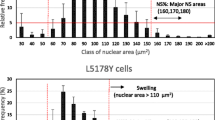Abstract
CHO cells undergo proliferative arrest when incubated in medium deficient in the amino acid arginine (ADM). Cells arrested in this way can be released and resume mitotic activity after a brief lag period. The incidence of U.V.-induced sister chromatid exchanges (SCEs) induced in cells arrested in ADM was reduced when the cells were incubated in ADM after irradiation and prior to release. Periods of incubation in ADM of 24 and 48 h prior to release reduced the resulting SCE levels (relative to the SCE levels present in cells irradiated immediately prior to release) by an average of 35 and 45% respectively. A similar time-dependent decrease in the incidence of chromosome aberrations induced in CHO cells arrested in ADM was not observed. Despite the decrease in SCEs over time in ADM, the survival of ADM-arrested cells was not enhanced by a period of incubation in ADM after irradiation of 48 h. These observations are consistent with the hypothesis that the U.V.-induced lesions responsible for the induction of SCE are repaired in time in ADM-arrested CHO cells. Repair of those lesions resulting in chromosome aberrations was not detected in ADM-arrested CHO cells. This absence of repair of certain lesions was apparently reflected in the absence of any enhancement of cell survival.
Similar content being viewed by others
References
Bartram, C.R., Koske-Westphal, T., Passarge, E.: Chromatid exchanges in ataxia telangiectasia, Bloom syndrome, Werner syndrome and xeroderma pigmentosum. Ann. Hum. Genet. 40, 79–86 (1976)
Bates, R.R., Wortham, J.S., Counts, W.B., Dingman, C.W., Gelboin, H.V.: Inhibition by actinomycin D of DNA synthesis and skin tumorigenesis induced by 7, 12-dimethylbenz(a)anthracene. Cancer Res. 28, 27–35 (1968)
Bertram, J.S., Heidelberger, C.: Cell cycle dependency of oncogenic transformation induced by N-methyl-N′-nitro-N′-nitrosoguanidine in culture. Cancer Res. 34, 526–538 (1974)
Bertram, J.S., Peterson, A.R., Heidelberger, C.: Lack of direct correlation among repair, oncogenesis, and lethality in cultures of synchronized mouse fibroblasts treated with N-methyl-N′-nitro-N-nitrosoguanidine. In: Molecular mechanisms for repair of DNA(B) (P.C. Hanawalt and R.B. Setlow, eds.), p. 789–796. New York: Plenum Press 1974
Carrano, A.V.: Chromosome aberrations and radiation-induced cell death. I. Transmission and survival parameters of aberrations. Mutation Res. 17, 341–353 (1973a)
Carrano, A.V.: Chromosome aberrations and radiation-induced cell death. II. Predicted and observed cell survival. Mutation Res. 17, 355–366 (1973b)
Carrano, A.V., Heddle, J.A.: The fate of chromosome aberrations. J. theor. Biol. 38 289–304 (1973)
Chaganti, R.S.K., Schonberg, S., German, J.: A manyfold increase in sister chromatid exchanges in Bloom's syndrome lymphocytes. Proc. nat. Acad. Sci. (Wash.) 71, 4508–4512 (1974)
Griggs, H.G., Bender, M. A.: Photoreactivatton of ultraviolet-induced chromosomal aberrations. Science 179, 86–88 (1973)
Grote, S.J., Revell, S.H.: Correlation of chromosome damage and colony forming ability in Syrian hamster cells in culture irradiated in G1. Curr. Top. Radiation Res. Quart. 7, 303–309 (1972)
Hahn, G.M.: Radiation and chemically induced potentially lethal lesions in non-cycling mammalian cells: recovery analysis in terms of X-ray and ultraviolet-like systems. Radiation Res. 64, 533–537 (1973)
Kato, H.: Induction of sister chromatid exchanges by chemical mutagens and its possible relevance to DNA repair. Exp. Cell Res. 85, 239–247 (1974)
Kato, H.: Photoreactivation of sister chromatid exchanges induced by ultraviolet irradiation. Nature (Lond.) 249, 552–553 (1974)
Kato, H.: Possible role of DNA synthesis in formation of sister chromatid exchanges. Nature (Lond.) 252, 739–741 (1974)
Kato, H.: Spontaneous and induced sister chromatid exchanges as revealed by the BrdU-labelling method. Int. Rev. Cytol. 49, 55–97 (1977)
Kihlman, B.A.: Caffeine and chromosomes. New York: Elsevier Scientific Publishing Company 1977
Little, J.F.: Factors influencing the repair of potentially lethal radiation damage in growth-inhibited human cells. Radiation Res. 56, 320–333 (1973)
Perry, P., Evans, H.J.: Cytological detection of mutagen-carcinogen exposure by sister chromatid exchange. Nature (Lond.) 258, 121–125 (1975)
Sasaki, M.S.: Sister chromatid exchange and chromatid interchanges as possible manifestations of different DNA repair processes. Nature (Lond.) 269, 623–625 (1977)
Sperling, K., Wegner, R.D., Riehm, H.: Frequency and distribution of sister chromatid exchanges in a case of Fanconi's anemia. Humangenetik 27, 227–230 (1975)
Stich, H.F., San, R.H.C.: DNA repair and chromatid anomalies in mammalian cells exposed to 4-nitroquinoline-1-oxide. Mutation Res. 10, 389–404 (1970)
Stich, H.F., Stich, W., San, R.H.C.: Chromosome aberrations in xeroderma pigmentosum cells exposed to the carcinogens, 4-nitroquinoline-1-oxide and N-methyl-N′-nitrosoguanidine. Proc. Soc. exp. Biol. Med. 142, 1141–1144 (1973)
Weerd-Kastelein, E.A. de, Keijzer, W., Rainaldi, G., Bootsma, D.: Induction of sister chromatid exchanges in Xeroderma pigmentosum cells after exposure to ultraviolet light. Mutation Res. 45, 253–261 (1977)
Wolff, S., Bodycote, J., Painter, R.B.: Sister chromatid exchanges induced in Chinese hamster cells by U.V. irradiation of different stages of the cell cycle: the necessity for cells to pass through S. Mutation Res. 25, 73–81 (1974)
Wolff, S., Rodin, B., Cleaver, J.E.: Sister chromatid exchanges induced by mutagenic carcinogens in normal and xeroderma pigmentosum cells. Nature (Lond.) 265, 347–349 (1977)
Author information
Authors and Affiliations
Rights and permissions
About this article
Cite this article
MacRae, W.D., MacKinnon, E.A. & Stich, H.F. The fate of U.V.-induced lesions affecting SCEs, chromosome abberrations and survival of CHO cells arrested by deprivation of arginine. Chromosoma 72, 15–22 (1979). https://doi.org/10.1007/BF00286427
Received:
Accepted:
Issue Date:
DOI: https://doi.org/10.1007/BF00286427




